Walking within the Lines: The Films of James Mangold
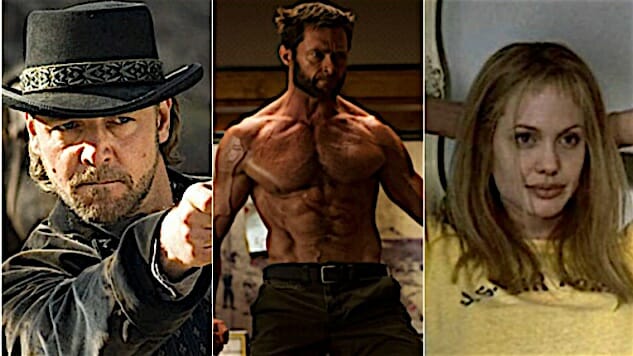
A musical biopic, a superhero tentpole picture, a Western, an Agatha Christie-inspired slasher, a Christmas-day feel-good rom com. Within American cinema’s genre landscape, these categories are about as far-flung from each other as “far-flung” can get, except they’re all represented within the oeuvre of the chameleonic James Mangold, who has been steadily cranking out feature-length films for the past 22 years. Born on Dec. 16, 1963, to celebrated painters Robert Mangold and Sylvia Plimack, Mangold got into film at a young age and continued pursuing his passion first at the California Institute of the Arts and then at Columbia film school, where he earned his MFA under the mentorship of Milos Forman. Mangold’s first major stint was co-writing for Walt Disney’s 1988 Oliver & Company, but his breakthrough took place with directorial debut Heavy, which won the best directing prize at Sundance in 1995.
Since then, Mangold has settled into a groove of pumping out highly diverse pictures that, nonetheless, bear faint traces of an auteur’s stamp. One such mark is a recurring fascination with outsiders, whether they are an 18th century duke in modern-day Manhattan, an unloved son or a certain clawed vigilante facing immortality alone. Paradoxically, this narrative affinity for fringe figures coincides with a staunch adherence to established aesthetic molds, a tendency that makes Mangold’s work feel both highly accessible and sometimes tame to a fault. Conventionality in itself is not necessarily bad, however, and when Mangold’s films work, they work really well. Often, the filmmaker’s pictures bring out the best of their respective genres, whether through confirming the power of musical and dramatic performance in the biopic or reminding us of the grandeur and soul of the classical Western. That said, it is also when Mangold pushes against the boundaries of tradition that his films are most exciting, inviting hope that, somewhere in the near future, the filmmaker will excel not just inside the box but outside it.
With Mangold’s Logan ripping up theaters in its opening weekend and his career having just passed the two-decade mark, we thought it would be fitting to look back on the career of a filmmaker who has, for the most part, produced a stream of strong, steady work. Though less well known than a Fincher or a Tarantino, Mangold has made considerable contributions to American cinema and thus deserves to be recognized.
Heavy (1995)
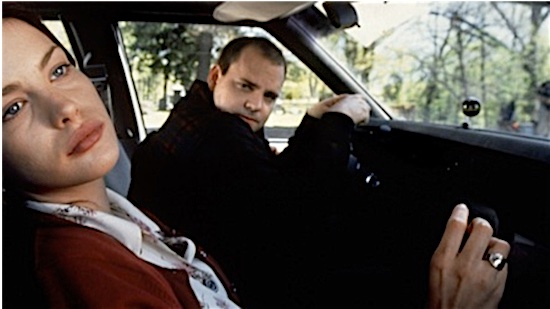
The plot of Mangold’s debut is, on the whole, pretty standard—an outsider named Victor spends his days in humdrum solitude until he meets someone who prompts him to emerge from his shell and take control of his life—but the details of its unfolding amount to something quite remarkable. Take, for instance, the way in which, out of the five main players in the film’s small ensemble cast, our protagonist is the fourth-to-last person we meet. The girl who changes his life is shown interviewing for a position at a tavern where Victor works, except this conversation is presented largely offscreen, with our perspective being tied instead to one of the other tavern workers who will, later in the film, slide into the narrative periphery as originally marginal characters edge into the spotlight.
This subtle readjusting of perspective seems at first to distract from the primary plot of the film, but, in fact, the inclusion of multiple points of view does something crucial. By giving us glimpses into lives and vantage points outside those of the two main characters, Mangold nudges the boundaries of the narrative proper toward a whole world of stories beyond what we see. Without deviating too much from focusing on Victor, Heavy ignites our empathy for characters that other films would have treated as throwaway. This large-hearted humanism is central to the appeal of Heavy, which manages to encourage compassion in viewers while retaining an unsentimental, down-to-earth approach to drama.
In the film’s lovely penultimate scene, the leftward panning motion of the camera is matched across a string of four shots, each of which contains various characters we’d met thus far. This motional and kinetic unity, which brings to mind the panoramic ending of Krzysztof Kie?lowski’s Three Colors: Blue, concludes both Victor’s story and the film’s pseudo world building in masterful fashion: on one level, all these people have, for better or for worse, brought Victor to where he is. On another, despite not being the heroes of this story, these characters all possess value in and of themselves, wounded seekers of meaning within a cold and enigmatic existence.
Cop Land (1997)
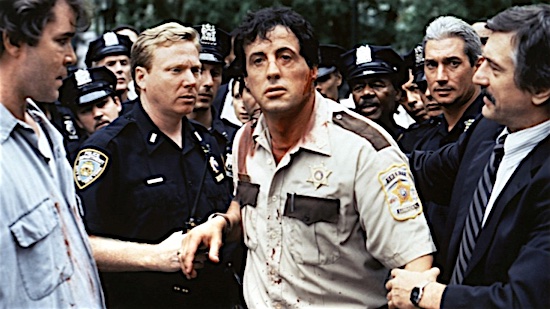
Though the film’s story would have us believe as much, the central question in Cop Land is not how a mild-mannered sheriff named Freddy Heflin will become entangled in the troubles of a bunch of crooked cops who use his sleepy town as a front for their illegal activities, nor how this convergence of paths will play out. Rather, the reigning mystery in Mangold’s second feature surrounds how the film managed to draw so much talent and still end up this average.
For its tale of big-city corruption and hard-jawed boys in blue, Cop Land couldn’t have landed a better cast. Robert DeNiro, Harvey Keitel, Ray Liotta, Sylvester Stallone, Robert Patrick, and numerous others—Mangold’s sophomore feature is jam-packed with some of film history’s most iconic tough guys, and moreover, they’re roaming through a story that demands the kind of hammy dialogue and tense standoffs that made them famous. And yet, Cop Land lacks the energy that animated a film like Goodfellas, partly because the filmmaking is too by-the-books (the bland cinematography is functional rather than aesthetic, never doing more than capturing events with the compositional awareness of a basic cable drama) and partly because the storytelling is too diffuse to create the kind of focused intensity Cop Land would have benefitted from. (The film introduces an enormous number of plot threads but discards most of them by the time of the climax, suggesting that Mangold realized too late that he’d committed to too much story and didn’t know how to pull it all together.)
All this is a shame, because the film has a lot of fascinating ideas lying nascent, missed opportunities that better filmmaking could have made bloom. The tribalism of the NYPD, the way police officers patronize the half-deaf, wannabe cop Freddy, the psychological toll this condescension takes on him, and the complex motivation behind his eventual decision to take action—these are all highly interesting thematic foci that could have been better accentuated through snappier filmmaking, tighter plotting and more expressive acting (especially from Stallone, whose lethargic performance, though it feels right for the character of Freddy, could still have been tempered by more signs of inner life). When a film this promising falls this flat, the disappointment hits like a round of bullets.
Girl, Interrupted (1999)
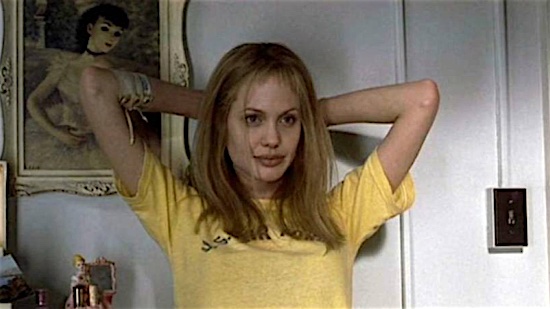
Angelina Jolie won an Oscar for her role in Girl, Interrupted, and rightly so. Playing Lisa, a longtime patient of an all-female mental institution, Jolie is a hurricane. Her character sweeps through the halls of her ward as an embodiment of anarchy, oscillating from being the ringleader of the other patients to being their tormenter. “I am free!” Lisa exclaims at one point, a statement that could very well have been uttered by Jolie about her own acting. For whereas many of the actress’ co-stars deliver relatively mannered, one-dimensional performances, Jolie feels relaxed and unhinged, totally comfortable in her character’s skin. In a powerful act of synergy between Jolie’s acting and Mangold’s script—which was adapted from Susanna Kaysen’s memoir—Girl, Interrupted keeps Lisa’s inner life inaccessible to us for much of the film. (Note that inscrutability is different from one-dimensionality, which suggests no inner life at all.) The character’s poker face renders her that much more fascinating, with her increasingly alarming actions coming to embody humanity in all its nuance and irrationality. Sometimes, the deepest pain expresses itself in outwardly outlandish ways that can’t be easily explained, and if the ending of Girl, Interrupted falls a bit flat, it’s because it tries to explain too much.
As epitomized by the character of Lisa, the most compelling moments of Mangold’s film are marked by ambivalence. At one point in the movie, a character actually provides a definition of ambivalence as being, if not in these exact words, a state of indirection generated by two opposite forces at play. Such is the plight that plagues the character of Kaysen, a young woman who, though not clinically insane, feels as out of place in the real world as she does in the mental hospital, if not more so. Indeed, though Lisa’s “I am free” comment seems wry at first glance given her de facto imprisonment within the psych ward, it might not be as sardonic as it appears. For though the mental hospital has its walls, guards, and strictly enforced daily regimen of activities, the outside world is itself saddled with rules and expectations. In fact, it is in the hospital, a socially sanctioned space designed specifically for the “crazy” ones, where the girls experience, in many respects, more freedom to be themselves.
Kate & Leopold (2001)
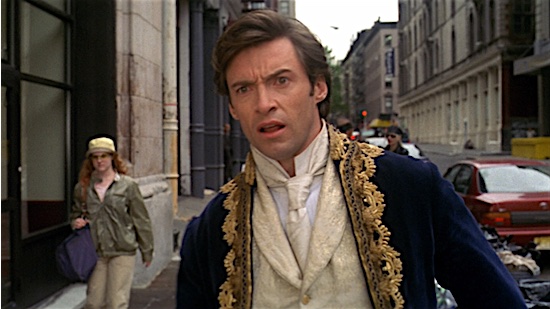
Kate & Leopold, a film about an 18th century duke named Leopold who accidentally time travels to 21st century Manhattan and falls in love with successful businesswoman Kate, is appealing in many generic ways, and yet there are grace notes sprinkled throughout that liven up the usual formula of the Christmas-day studio rom-com. Consider, for instance, the 18th century-set opening scene, in which the architect of the Brooklyn Bridge is seen calling his creation “the greatest erection on the planet” to the delight of one onlooker. Our first reaction is to gag at the juvenility of it all, but then we see that this guy is the only person laughing. Later, we find out that he is from the future where such penis jokes are a sorry mainstay, and we retroactively realize that his solitary amusement functioned as a neat bit of foreshadowing.
Also striking is how the specific modern-day gag evoked in this opening scene is such a lame one, because part of the bite of Kate & Leopold lies in the way it upends the notion that the present is superior to the past. True, some of the film nostalgizes bygones a bit too much (spoilers for the rest of this paragraph), such as in the mildly unsettling finale where it is suggested that only a man can fill the void that female careerism could never provide. Moreover, in order to be with Leopold, Kate travels back to a time when women lacked most of the freedoms they enjoy today. Yikes.
Still, the film does expose—and rather cleverly at that—certain holes in the myth that we are unequivocally better now than we were before. In one hilariously uncomfortable scene, Kate’s lecherous boss JJ puts the moves on her, except he does so by praising her empowered status as a woman who is supposedly unbound by traditional standards of femininity. “You don’t do pretty,” he says with barely contained lasciviousness, and the punchline of this moment is that, though the guy uses words that imply an endorsement of feminism, it is clear that he is as misogynistic as any other dude from Western civilization’s sexist past. By contrast, it is the seemingly antiquated Leopold who treats women with respect, who is cordial without being patronizing and who repeatedly asks for consent during courtship.
For all the sweetness of its meet-cute scenario, it is these thoughtful, witty moments that stand out in Kate & Leopold, leading to reflection on the perils of over-exalting the modern moment as well as the pleasure of a charmingly executed rom-com.
Identity (2003)
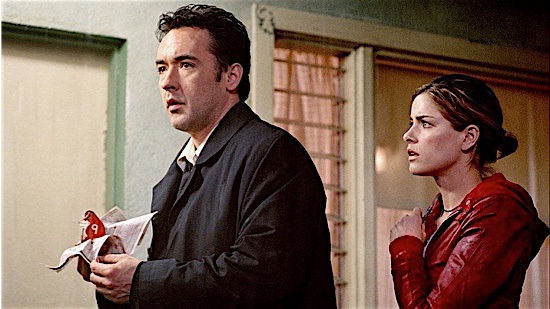
Following the springy charm of Kate & Leopold, Mangold did a complete 180 to helm Identity, a modern-day reimagining of Agatha Christie’s And Then There Were None. The two films are, however, less different than they may initially seem, for both embody a full-on embrace of genre—Kate & Leopold the big-studio rom-com, Identity the twisty whodunit that is literally set during a dark and stormy night and feels like a marriage between M. Night Shyamalan and Alfred Hitchcock. Like with Kate & Leopold, however, Mangold innovates aplenty despite working within a well-established framework, introducing clever bumps and swerves in a ride that could very well have been smooth, dull and uneventful.
Little can be said about the story without giving away major plot points, but if you’ve read the source novel, you’ll appreciate how Mangold reproduces the mysteriousness of the book’s premise before taking the story into stranger, loonier territory. Some may consider the film’s ending a cop-out, but I think it’s kind of brilliant. There, Mangold performs a rug-pulling that retroactively causes us to reevaluate all that had come before. The twist delivers a pleasing jolt in and of itself, but it also draws attention to the cinematic and narrative devices that Mangold had used thus far to conjure atmosphere and generate suspense.
In other words, Identity ultimately becomes, in a sense, a thriller about the creation of thrillers, one where all that had theretofore seemed to be coincidence is revealed to be anything but. The intentionality underlying the film’s events was cleverly alluded to in the film’s Magnolia-esque opening scene, in which the absurdity of the seeming happenstance that brought all the film’s characters together suggested an all-seeing, all-knowing power who was pulling the strings. Turns out, this deity was Mangold himself, who, despite being partially boxed in by the trappings of the genre, has the wicked fun of someone in control.
Walk the Line (2005)
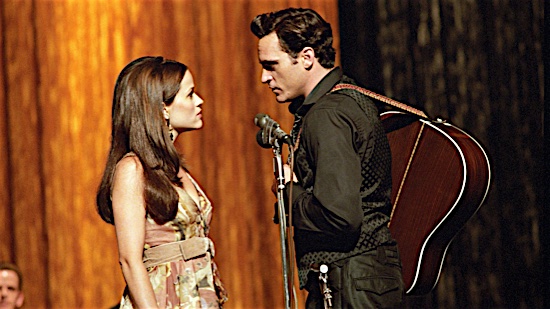
For much of its runtime, Walk the Line seems like one of Mangold’s most conventional films: a Great Man biopic that throws in just enough dirt—he sleeps around! He pops pills!—to “humanize” the subject and evade accusations of hagiography. But then the film keeps on throwing, keeps looking on as Johnny Cash spirals down the whirlpool of his own addictions and demons, to the point where, by the film’s latter half, it is clear that we are not looking at a hero but a genuinely, often unpleasantly flawed guy. Joaquin Phoenix, one of this generation’s great actors, doesn’t just parrot the great country singer’s baritone voice or onstage mannerisms, though Phoenix does nail those to a tee. He embraces Cash’s pathetic, offstage indecency and irresponsibility along with the tabloid-ready moments in the limelight, convulsing with the same pain that gripped the Man in Black.
As Cash unravels before our eyes, what is clear is that Walk the Line is not about a Great Man but the Great Woman who saves him—June Carter, incarnated by Reese Witherspoon in a stunning performance. This woman bears her share of baggage as well, and the film isn’t shy about occasionally sidelining Cash to focus on what she’s going through—the phony front she feels she has to put on for crowds in order to compensate for her supposed lack of talent, the disgust she faces from conservative folks of her parents’ generation, the difficulty of being both in showbiz and a single mother of two. If anything, the fact that she’s dealing with this much and still takes on the burden of caring for the drug-dependent, womanizing Cash reveals that she is the true hero of this story.
3:10 to Yuma (2007)

One of Mangold’s best films to date is also one of his most straightforward. Though outfitted with the faces of today’s stars, 3:10 to Yuma is a classical Western through and through, telling a tale of camaraderie and redemption in the lawless plains of the American heartland.
Following a ragtag team of characters as they try to escort a notorious criminal to a prison-bound train while the outlaw’s hooligans are in hot pursuit, the film is, as many of the best ones are, as much about the journey as the destination. Within this journey, it is not the physical chase itself that fascinates the most, though this aspect is plenty thrilling, given that the embattled crew encounters obstacles as varied as gun-toting Apaches and sadistic railwaymen. Rather, the heart of the film lies in the relationship between outlaw Ben Wade and rancher Dan Evans, who volunteers for the dangerous mission because he needs the $200 payment to save his home.
At face value, these two are seeming opposites. Ben is a confident, unruly womanizer and a wanton murderer, driven by a you-take-what-you-want kind of mentality. Dan, on the other hand, is a handicapped Civil War veteran whose morale and self-respect have been beaten down by poverty, physical limitation and the disgusted way in which his son looks at him. His journey is for money, but it is also to reclaim some semblance of dignity. When these two personalities clash over the course of the film, both men bring out attributes in the other that neither expected, with Mangold’s steady direction and Halsted Welles’ spry dialogue helping to develop the uneasy dynamic between the two characters in ways both poignant and surprising. The film’s fiercely moving finale is a culmination of this relationship, and though the gunplay grabs our attention, it is the undercurrent of soul that sweeps us away.
Knight and Day (2010)
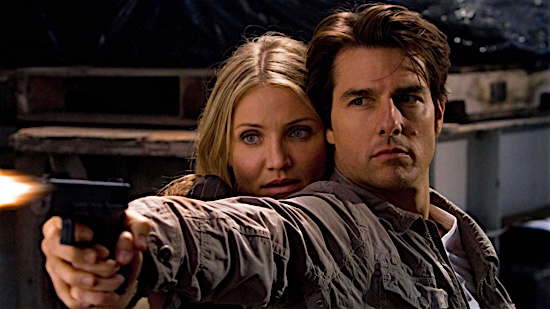
In between gifting us with a formidable latter-day Western and helming one of the stronger editions to the X-Men franchise, Mangold wasted his energy on a throwaway spy saga starring Tom Cruise as a renegade CIA agent and Cameron Diaz as the gal who falls for his iconic looks and chiseled physique.
It’s difficult not to enjoy watching Cruise, one of the great action stars of our time, riding guns-a-blazing on the hood of a speeding car or motorbiking through the streets of Sevilla alongside a herd of Spanish Fighting Bulls. But these stunts, while cool on paper, aren’t anything we haven’t seen before, resulting in action scenes that, in retrospect, feel like the actor warming up for 2011’s much superior Ghost Protocol. And while Diaz’s sunny disposition makes for an amiable screen presence, her role as distressed damsel June Havens conforms to the same, ditzy-blond stereotype she’s been boxed into for years. The fact that June is a car geek suggests an effort to break from convention, but in practice, it feels more like the screenwriters tokenistically adding “quirk” to the character than a genuine stab at creating something original. (This reality is confirmed by how irrelevant June’s vocation is to the story proper.)
Cruise as the buff daredevil, Diaz as the scatterbrained girl-next-door—throw in Peter Saarsgard as the snaky villain and Viola Davis as the tough-as-nails CIA head honcho and it becomes clear that Knight and Day is risibly rife with typecasting. These hackneyed casting decisions could have been used to parody the way Hollywood recycles the same, one-dimensional characters through “different” roles that are de facto the same. Alas, the film tells its story with nary a wink, letting the typecasting remain just that and moseying on along in total ignorance of its own mediocrity.
The Wolverine (2013)
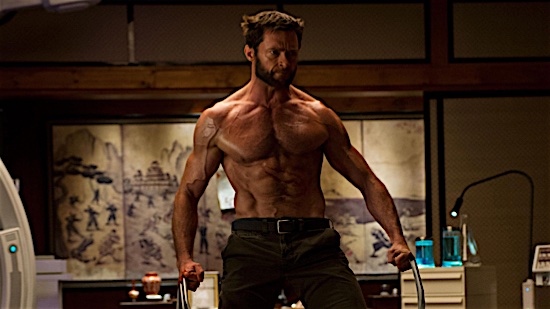
Its dull finale aside, Mangold’s first entry in the X-Men franchise is a roaring, often beautiful action opus with a startling philosophical vein. The action dimension manifests in some of the series’ best fight scenes to date, lucidly shot by Ross Emery and cleanly edited by Michael McCusker. The most exciting set piece happens early on, beginning at a funeral, snaking through the streets of Tokyo, and ending atop one of Japan’s high-speed bullet trains. In this sequence, claws, katanas, guns, and arrows all come into play in ways both surprising and satisfyingly predictable. Seeing Hugh Jackman tussle with Yakuza thugs is about as much fun as you’d expect.
Another strength of The Wolverine lies in the fact that, since Logan has taken his grouchy, grizzled heroics to the other side of the world, the scenery has shifted with him. In lieu of the bland visual mix of metallic interiors and drab outdoor cinematography typical of many Marvel movies, The Wolverine takes in the architectural and scenic beauty of modern-day Japan, spanning the gamut from Tokyo high-rises to a quaint fishing village just outside Nagasaki. Granted, the film is far from a thorough exploration of Japanese culture, but it treats the milieu it depicts with respect, a posture that is echelons superior to the Far-East exoticism historically favored by so many globetrotting blockbusters.
Per expectation, the bulk of The Wolverine focuses on spectacle and kinesis, foregrounding the poetry that can be found in bodies moving brutally through beautiful locations. And yet, this film also goes where none of the other X-Men films have gone in painting Logan as, perhaps, one of the most tragic superheroes of all time: a man cursed with immortality, able to endure pain but never to escape it. At one point, a character calls Logan a ronin—“a samurai without a master”—and it is the ronin-esque sense of eternal wandering that makes Wolverine such a poignant hero. He passes from one story to the next, saving others but with no one to save him. I would’ve preferred a movie that leaned more heavily into this philosophical angle, but even a cursory gesture in that direction places The Wolverine above so many of its genre counterparts, imbuing the film with a quiet majesty.
With Logan now receiving widespread praise and gunning for the title of biggest box office opener of 2017, it’s likely that Marvel’s clawed superstar will come to be the name most closely associated with Mangold’s own. However, this pairing of character and filmmaker is fitting in ways that extend beyond the director’s X-Men films to Mangold’s filmography as a whole. For just as our clawed hero is marked by itinerancy, moving from one narrative to the next over the course of his undying existence, so Mangold has himself been a wanderer, applying his sure-footed filmmaking to one genre after another throughout his career. And just as Logan’s healing powers and warrior’s stamina keeps him steady under fire, so Mangold appears to possess a preternatural steadfastness of his own, continually producing works of quality with only a few missteps along the way. This kind of variety and consistency is rare. When it appears, it deserves our attention.
Jonah Jeng is a writer and prospective film studies graduate student whose work has been featured in The Film Stage, Taste of Cinema and Film Matters Magazine. For him, joy is found in the company of loved ones, the enchantment of cinema and the wholesale consumption of avocado egg rolls.







































